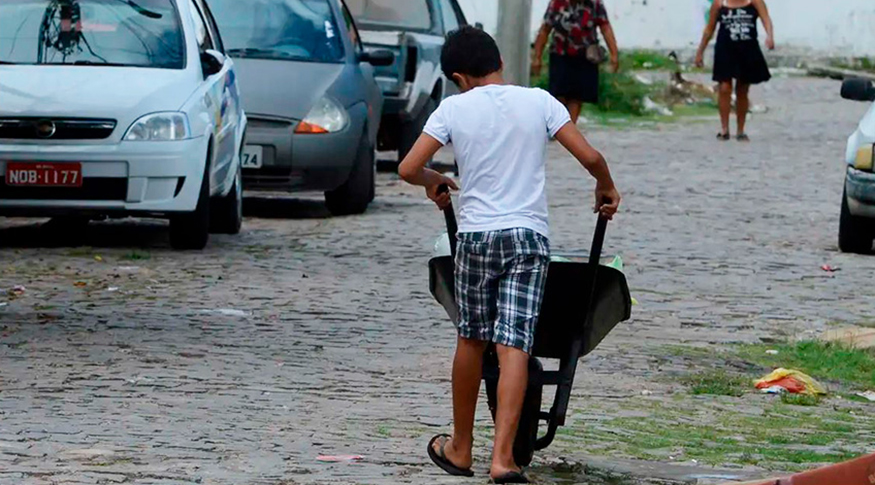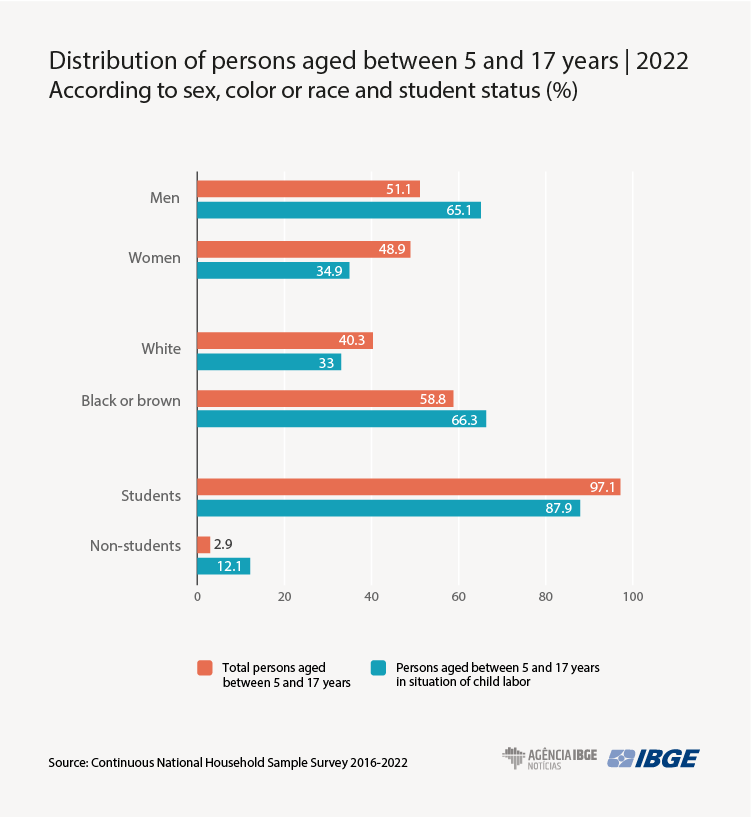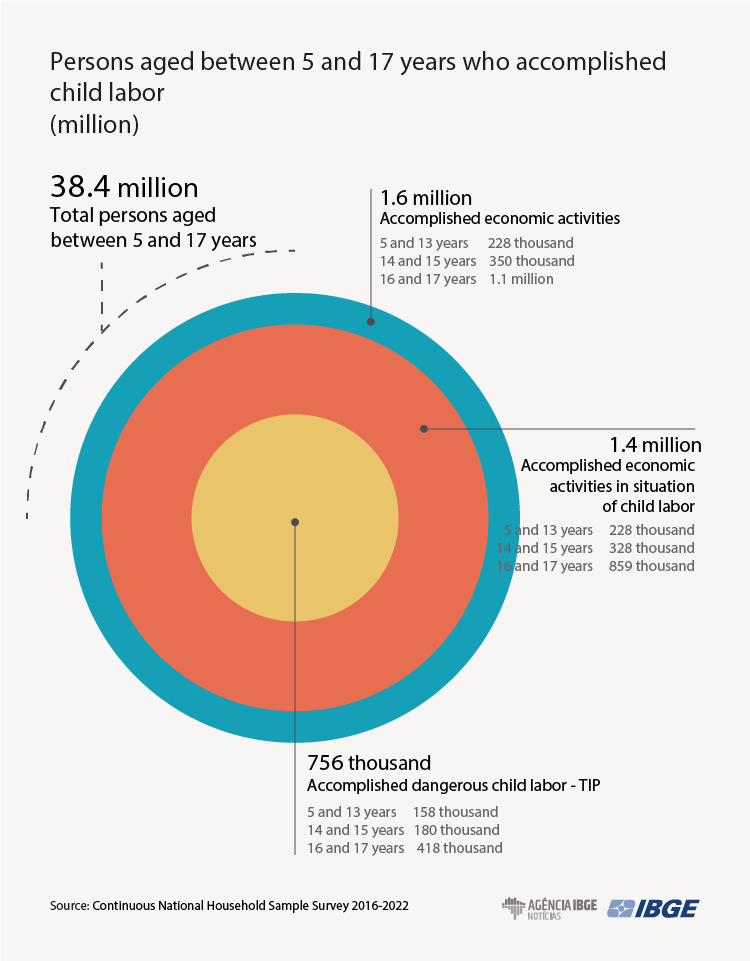Continuous PNAD
Child labor increased in Brazil between 2019 and 2022
December 20, 2023 10h00 AM | Last Updated: December 26, 2023 11h59 AM
Highlights
- In 2022, Brazil had 1.9 million children and teenagers aged between 5 and 17 years (or 4.9% of this age group) in situation of child labor. That contingent had dropped from 2.1 million (or 5.2%) in 2016 to 1.8 million (or 4.5%) in 2019, though it grew in 2022.
- Between 2019 and 2022, the Brazilian population aged between 5 and 17 years decreased 1.4%, though the contingent of this age group in situation of child labor increased 7.0%.
- In 2022, 756 thousand children and teenagers exerted the worst forms of child labor, which either involved the risk of accidents or jeopardized their health, listed on the TIP list.
- Among children and teenagers in situation of child labor in 2022, 23.9% were aged between 5 and 13 years, 23.6%, between 14 and 15 years and 52.5%, between 16 and 17 years.
- Among teenagers aged between 16 and 17 years in situation of child labor, 32.4% worked 40 hours or more per week.
- Male children and teenagers in situation of child labor (65.1%) prevailed in relation to the female ones (34.9%).
- Nearly 76.6% of the teenagers aged between 16 and 17 years working in economic activities were in the informality, the equivalent to 810 thousand informal child workers. It was the highest percentage of informality for that group since the beginning of the time series in 2016.
- The proportion of either black or brown persons in child labor (66.3%) surpassed the percentage of this group in the total number of children and teenagers in Brazil (58.8%). On the other hand, the proportion of white persons in child labor (33.0%) was smaller than its share (40.3%) in the total number of children and teenagers.
- Earnings of girls in situation of child labor (R$639) was equivalent to 84.4% of earnings of boys (R$757) in this situation.
- Earnings of either black or brown children and teenagers in child labor (R$660) was equivalent to 80.8% of earnings of white children and teenagers (R$817) in this situation.

In 2022, 1.9 million children and teenagers aged between 5 and 17 years were in situation of child labor in Brazil. It represents 4.9% of the population in that age range. The contingent of children and teenagers in this situation had been dropping since 2016 (2.1 million), the first year of the module on labor of children and teenagers of the Continuous PNAD, hitting 1.8 million in 2019. However, that contingent grew in 2022.
The data released today (20) by the IBGE are part of the Experimental Statistics, which should be used with caution. The major focus of the survey is the adoption of Resolution IV of the 20th International Conference of Labor Statisticians, held in 2018 in Geneva.
Among those who were in child labor in 2022, 1.4 million were employed in economic activities, whereas 467 thousand produced for self-consumption. The economic activities involve some work in the reference week paid in cash, products or goods or even unpaid, when they help in the economic activity of relatives.
The production for self-consumption produces goods and services for exclusive use of the household residents. Some activities related to self-consumption are farming, fishing, hunting, animal breeding or construction and repairs in their own households.
“Of the 38.4 million persons aged between 5 and 17 years in Brazil, 2.1 million persons carried out economic activities or production for self-consumption or both of them simultaneously. It is important to highlight that not all the work carried out by persons in that age range is considered child labor,” details Adriana Beringuy, the IBGE´s Coordinator of Household Sample Surveys.
For the International Labor Organization (ILO), child labor is “that work which is dangerous and harmful to the health and the mental, physical, social or moral development of children and which interferes in their schooling.”
In the Continuous PNAD, the criteria adopted for that definition were age range, type of activity developed, worked hours, attendance to school, accomplishment of dangerous child labor and economic activities in situation of informality.
Between 2019 and 2022, number of children and teenagers in child labor grew 7.0%
Between 2016 and 2019, while the number of children and teenagers aged between 5 and 17 years dropped 4.1%, the contingent in situation of child labor decreased even more (-16.8%). Nevertheless, between 2019 and 2022, the population aged between 5 and 17 years continued to decrease (-1.4%), though the contingent in situation of child labor increased 7.0%, changing from 1.758 million in 2019 to 1.881 million in 2022.
“We not only consider whether children and teenagers are in the labor market, but under which conditions they are working. Every child aged between 5 and 13 years employed in economic activities or in the production for self-consumption is in situation of child labor. However, the legislation allows the labor as young apprentices for the group aged between 14 and 15 years. Therefore, not all the cases are considered child labor. It is required to assess whether it is a job without a formal contract, whether it is a domestic work, whether the work hours are excessive, whether the job involves dangerous activities, jeopardizes their health or development,” explains the analyst.

More than half of child workers were aged between 16 and 17 years
More than half (52.5% or 988 thousand) children and teenagers in situation of child labor were aged between 16 and 17 years. The other age ranges had the following distribution: between 14 and 15 years (23.6% or 444 thousand persons) and between 5 and 13 years (23.9% or 449 thousand).
Child labor was more frequent among teenagers aged between 16 and 17 years: 16.3% of them were in this situation in 2022, whereas the proportion was 1.7% in the range between 5 and 13 years. Between 2016 and 2022, the percentage of children aged between 5 and 13 years in child labor remained stable. However, child labor grew 1.4 percentage points (pp) in the range between 16 and 17 years from 2019 to 2022.
Among those who were inserted in economic activities, teenagers aged between 16 and 17 years (60.6% or 858 thousand persons) prevailed. Among those who produced only for self-consumption, the proportion of the group aged between 5 and 13 years (47.5% or 222 thousand persons) was bigger.
32.4% of youngsters aged between 16 and 17 years exerted child labor for 40 weekly hours or more
Two out of five (40.6%) children and teenagers in situation of child labor worked up to 14 weekly hours and 14.0% worked between 25 and 39 hours per week. One out of four (24.9%) of these children worked between 15 and 24 weekly hours and one out of five (20.5%), for 40 hours or more.
The longer shifts were those of teenagers aged between 16 and 17 years: 32.4% of them worked for 40 hours or more in the week.
“We noticed that the work hours increase according to the age and the biggest proportion of those who work 40 hours or more stood with teenagers aged between 16 and 17 years. School dropout grows in that age group, which might contribute to a longer shift among part of those teenagers,” analyzes Beringuy.
Nearly two thirds of child workers are men
Male children and teenagers represented 51.1% of the population aged between 5 and 17 years in Brazil and 65.1% of those who were in child labor.
The proportion of either black or brown persons in situation of child labor (66.3%) surpassed the percentage of this group in the total number of children and teenagers in Brazil (58.8%). On the other hand, the proportion of white persons in child labor (33.0%) was smaller than its share (40.3%) in the total number of children and teenagers.
School attendance is smaller among child workers
Nearly 97.1% of the population aged between 5 and 17 years were students, though the proportion dropped to 87.9% among children and teenagers of this age range in situation of child labor.
Almost everyone (98.5%) in the age group between 5 and 13 years attended school, as well as those who were in situation of child labor in this age range (98.5%). In the range between 14 and 15 years, 98.5% attended school, though this rate was slightly lower (96.0%) among child workers in the same ages.
The age group between 16 and 17 years showed a greater difference: 89.4% of the population aged between 16 and 17 years attended school, though only 79.5% of the teenagers in these ages and in situation of child labor remained studying.

Informality rate reached 76.6% for youngsters aged between 16 and 17 years in economic activities
Among the teenagers aged between 16 and 17 years working in economic activities, the informality rate was 76.6%, the equivalent to 810 thousand informal workers. It was the highest percentage of informality for that group since the beginning of the time series of the survey.
The contingent of informal workers was concentrated in those employed in the private sector and in domestic workers (67.9%), followed by self-employed workers and employers without CNPJ (16.9%) and assisting family workers (15.2%).
Most of the children and teenagers aged between 5 and 17 years in situation of child labor in the main job were in non-agricultural activities (77.2%). Three out of five (59.1%) of those children and teenagers were inserted as employees, 26.8% as family workers and 14.1% as either self-employed workers or employers. Nearly 42.6% of those who were in child labor were in the group of other activities, 27.9% in trade, 22.8% in agriculture and 6.7% in domestic services.
756 thousand children and teenagers exerted the worst forms of child labor
Another point raised by the survey was the contingent of children and teenagers who were employed in the worst forms of child labor, according to the TIP list. The methodology used was developed with the support of the ILO, Ministry of Citizenship, United Nations International Children´s Emergency Fund (Unicef), Prosecutor´s Office of Labor and National Forum for Prevention and Eradication of Child Labor, among other institutions.
In 2022, Brazil had 756 thousand children and teenagers aged between 5 and 17 years in the worst forms of labor, which either involved risk of accidents or jeopardized their health. It is equivalent to 46.2% of 1.6 million children and teenagers who accomplished economic activities. That proportion fell from 51.3% in 2016 to 45.8% in 2019, though it rose to 46.2% in 2022. The involvement of those under 18 years in such activities is prohibited by Decree 6,481, of June 12, 2008.
More than two thirds (69.4% or 158 thousand) of children and teenagers aged between 5 and 13 years employed in economic activities exerted the worst forms of labor. That proportion retreated against 2016 (71.7%), though it has grown in relation to 2019 (64.8%). The percentages of the groups aged between 14 and 15 years (51.4%) and between 16 and 17 years (39.5%) were significant as well.
“The TIP list takes into account the forms of labor that mostly jeopardize children in their development. The list helps us to classify which children are under greater vulnerability,” says Beringuy. “Occupations like street vendor, car washer and machine operator, among others, are among the worst forms of child labor. The list includes activities in agriculture, industry, trade and services,” completes her.

Girls in child labor receive 84.4% of earnings of boys in the same situation
In 2022, the average real earnings of persons aged between 5 and 17 years who accomplished economic activities in situation of child labor was estimated at R$716.
Among children and teenagers in situation of child labor, boys earned R$757, whereas girls received 84.4% of this value (R$639).
Among children and teenagers in child labor with compensation, those black or brown ones received, on average, R$660, and the white ones, R$817.
Child labors who studied received, on average, R$671, whereas earnings of those who did not attend school reached R$931.

Social benefits reach 56.1% of children aged between 5 and 13 years in economic activities
In 2022, 582 thousand children and teenagers aged between 5 and 17 years who accomplished economic activities and lived in households assisted by governmental social programs (Bolsa Família or Continued Installment Benefit - BPC, of the Organic Law of Social Assistance - LOAS). That contingent represented 35.6% of the population aged between 5 and 17 years in economic activities.
In the range between 5 and 13 years of age, 56.1% of children and teenagers in economic activities lived in households that were benefited, a higher proportion than in the other age groups, like those between 14 and 15 years (38.9%) and between 16 and 17 years (30.1%).
For Adriana Beringuy, the current module on labor of children and teenagers of the Continuous PNAD is an opportunity to analyze the presence of the group aged between 5 and 13 years in the labor universe. That age group is not investigated by the monthly and quarterly editions of the survey, which include the population aged 14 years and over.
“We raise data on children and teenagers who accomplish economic activities or produce for self-consumption and try to measure their vulnerability. This information can be used as a basis to reflect on actions that contribute to reverse child labor in Brazil,” says the coordinator.
More about the survey
The Labor of children and teenagers module of the Continuous PNAD is carried out by the IBGE since 2016, by capturing data on economic activities and production for self-consumption, school and domestic activities accomplished by persons aged between 5 and 17 years. This module integrates the Experimental Statistics. This theme was not surveyed in 2020 and 2021, due to the change in the data collection of the survey, which began to be made exclusively through telephone. In this period, it was required to reduce the questionnaire, which expected face-to-face interviews. Therefore, the time series of this module includes the years from 2016 to 2019 and 2022.


















